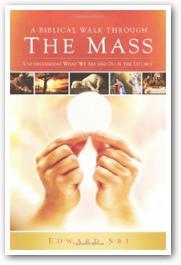“And with your spirit”
by EDWARD SRI
On the First Sunday of Advent, 2011, the new translation of the Mass will go into effect in U.S. dioceses. The structure of the Mass will be the same, but some of the responses by the people will change. This is the first of a series of articles on those changes and the reasons behind them.

But do we really grasp the meaning of these words? Do we understand the significance of what we are doing and saying in the sacred Liturgy?
The new English translation of the Mass, which will be promulgated the First Sunday of Advent (November 27), will provide a unique opportunity for Catholics to reflect on the meaning of the prayers in the Liturgy. This updated translation will bring about the most significant change in the way most English-speaking Catholics participate in the Mass since the years following the Second Vatican Council (1962–1965), when the liturgical texts were translated into English and officially used in worship for the first time. The basic structure of the prayers will remain the same, but the changes in wording at many points will be quite noticeable. For a time, most Catholics will no longer be able to walk into church on Sunday and automatically recite the Gloria, the Creed, and other Mass parts by memory. They will need a guide to help them become accustomed to the new translation of these prayers.
As we are taken out of our routine, we will have the opportunity to ponder the significance of all that we say and do at Mass and rediscover the splendor.
For example, consider the meaning behind one of the most noticeable changes found near the opening of Mass. It involves the people’s response to the priest’s greeting, “The Lord be with you.” In the new translation, we will reply, “And with your spirit.” This more adequately reflects the Latin text of the Mass (“et cum spiritu tuo”) and the biblical language of St. Paul (see Galatians 6:18; Philippians 4:23; 2 Timothy 4:22).
It also more fully expresses an important theological point. When we say, “And also with you” in the present translation, one might get the impression that our response was merely intended to express an exchange of personal greetings or reciprocal good will: “May the Lord be with you, too, Father.”
But there is much more to this response. When a man is ordained a priest, the Holy Spirit comes upon him in a unique way, enabling him to perform the sacred rites of the Mass and consecrate the Eucharist. By responding, “And with your spirit,” we acknowledge the Spirit’s activity through the priest during the sacred Liturgy. We are referring to the “spirit” of the priest, the very core of his being, where he has been ordained to offer the sacrifice of the Mass. Indeed, we are acknowledging that since God works through the priest who is offering the Mass, ultimately it is Jesus Christ who is the head of the community gathered for the Liturgy, and it is his Spirit who is the primary actor in the Liturgy, regardless who the particular priest celebrating Mass may be.
This is just one of many spiritual gems found in the new Mass translation.
ACKNOWLEDGEMENT
Edward Sri. “And with your spirit.” Fathers for Good (October 19, 2011).
Fathers for Good is an initiative for men by the Knights of Columbus.
This reflection is based on Edward Sri’s new book, A Biblical Walk Through the Mass: Understanding What We Say and Do in the Liturgy and is reprinted with permission from the author.Read a review of this book by Monsignor Joseph G. Priorhere.
THE AUTHOR Dr. Edward (Ted) Sri is provost and professor of theology at the Augustine Institute in Denver. Edward holds a doctorate from the Pontifical University of St. Thomas Aquinas in Rome. He resides with his wife Elizabeth and their five children in Littleton, Colorado. Edward Sri is the author of A Biblical Walk Through the Mass: Understanding What We Say and Do in the Liturgy, Mystery of the Kingdom, The New Rosary in Scripture: Biblical Insights for Praying the 20 Mysteries, and Queen Mother.
Copyright © 2011 Edward Sri

